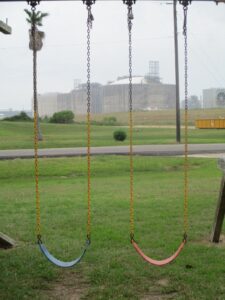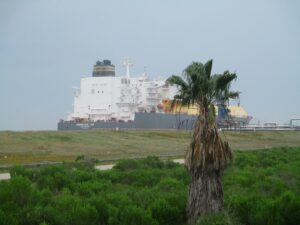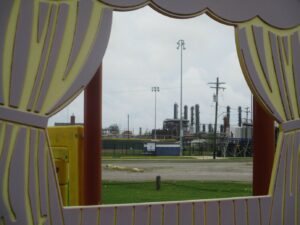In May 2023 Andy Gheorghiu travelled along the US Gulf coast and visited LNG export sites (operating, under construction and planned) which have been co-financed by German banks or enabled through longterm contracts with German companies. He experienced first-hand the impacts on local communities and the environment – and was surprised by what he found. Lots of what he has experienced and heard reminded him of issues one would have expected in the Global South. Here’s his look back. Read part 2 covering Louisiana.

Hillcrest Community, Corpus Christi, Texas. Credits: Andy Gheorghiu, All Rights Reserved.
Corpus Christi (May 5 and 6)
The first stop on the boat tour by the Ingleside On the Bay Watch Association is at the Corpus Christi LNG export terminal of Cheniere – co-financed by German banks as outlined in my co-written report “Investigating in climate chaos: How German banks and companies enable fracking LNG projects”.
Ship traffic has increased significantly also due to the LNG export terminal – which requires dredging for the deepening of the water channel. This is impacting the seaweed which provides a livelihood for dolphin populations in the area. The LNG tankers also drive close by to people’s homes, causing damage to the properties – for example through the waves they’re creating.

Home impacted by ship traffic. Credits: Andy Gheorghiu, All Rights Reserved.
Surprisingly, it’s no problem to get very close to the facilities (including a tanker which is being apparently filled with LNG). We see constant flaring with often much bigger flares and learn later from Chispa Texas and the residents of Gregory (Corpus Christi area) who live nearby that they’re being notified via SMS about Cheniere’s flaring operations – which happen on a monthly or even weekly basis. Flaring is the burning of gas that would otherwise be released into the atmosphere. Flaring is often used as an emergency measure to burn off gasses that are released during operational problems. State regulators have repeatedly raised pollution limits for Cheniere’s LNG terminal. Environmental groups consider Corpus Christi LNG to be an environmental injustice in Texas‘ coastal bend.

Flaring at Cheniere’s Corpus Christi LNG facility on May 5 2023 and community notice on April 10 2023. Credits: Andy Gheorghiu, All Rights Reserved.
It is hard to see any economic benefit for big parts of the Corpus Christi area (CCA) and the most impacted communities. To the contrary, I learn from the Texas Campaign for the Environment that people of color from the Hillcrest community (CCA) who are forced to live next to a big refinery are advised not to grow any vegetables because the soil is highly contaminated. Moving away is for some or even many not an option – either they can’t afford it, or they don’t want to leave their families behind.
Elida Castillo, resident of Tafta, Corpus Christi, Texas and programme director of Chispa, Texas [statement recorded during the tour in Gregrory, Corpus Christi, Texas]:
“I am concerned about the buildout, especially of Cheniere LNG, the impact its having on our communities. It’s affecting our health, its affecting our environment, its affecting our bays and contributing to the erosion of our communities and our quality of life.”
Companies like Cheniere are getting tax abatements in the Corpus area while the African American poverty rate in Gregory was at 28.4% in 2021 and the Latino poverty rate was at 20.7%.
Shockingly, while poverty rates are significant, I hear that cancer rates are running high at all places during this toxic tour. Places I will visit are listed by UN’s Special Rapporteur on Human Rights and the Environment among the 50 of most polluted places on Earth. Even if cancer rates are not directly linked to poverty rates, the fact is that poor people are often forced to live near polluting facilities.
Freeport (May 7)
The ugly scars of historical racism are still fresh in Freeport. The East End neighborhood was a vibrant black community – initially formed by segregation in the 1930s. It is now surrounded by the Port of Freeport and several fossil fuel and petrochemical facilities – among them BASF, Dow and Freeport LNG. The port has been constantly buying property in the East End for more than 20 years, in effect, erasing the black community. Today only a few of the original locals are left – and continue to fight for their right to stay.

Children’s playground nearby the Freeport LNG. Credits: Andy Gheorghiu, All Rights Reserved.
Freeport LNG is another terminal which was co-financed by German banks (such as Deutsche Bank). Almost 70% of its LNG exports go to Europe. A massive explosion in June 2022 horrified residents and slashed overall US fracked gas exports by 20%. Questions about this event remain unanswered, in particular around seemingly non-existing safety plans and a proper alert system. The terminal was built near a popular beach. A children’s playground and a small visitors centre are situated right next door to the facilities.
Melanie Oldham, Better Brazonia, Freeport resident [recorded as part of the “The dark side of US LNG” short documentary]:
“These companies could prevent a lot of these emissions and cancer and health and breathing problems but instead they build a cancer center, and you can only go there if you have really good insurance.”

LNG tanker nearby the Freeport LNG. Credits: Andy Gheorghiu, All Rights Reserved.
Members of Citizens for Clean Air and Water of Freeport and Brazonia County called on regulators to keep Freeport LNG closed – but the terminal received approval to reopen in February 2023. Local activists such as Melanie Oldham and Gwendolyn Jones continue to fight against Freeport LNG and its ongoing threat.
Port Arthur (May 8)
Guide John Beard from the Port Arthur Action Network (PACAN) leads a so-called toxic tour through the “belly of the beast” – his name for the Port Arthur industrial area. I only get out of the car a few times for a few minutes but I already get headaches and an itchy throat. Port Arthur is a predominantly black coastal town surrounded by many petrochemical facilities (some very close to children’s playgrounds) and LNG export terminals. The African American poverty rate here was at 26.4% in 2021.

Children’s playground nearby petrochemical facilities in Port Arthur. Credits: Andy Gheorghiu, All Rights Reserved.
A report published by the Environmental Integrity Project in 2022, revealed that five Texan refineries polluted above the federal limit on cancer-causing benzene – among them Total Energies at Port Arthur.

Fossil fuel facilities in Port Arthur. Credits: Andy Gheorghiu, All Rights Reserved.
PACAN also fights for lower pollution limits at the Port Arthur LNG export terminal – something a judge agreed should happen but the Texas Commission on Environmental Quality refused to impose on the operator Sempra Infrastructure.
The final investment decision for the construction of the LNG facility – made shortly after Sempra met with the German chancellery – has also been made possible by longterm contracts Sempra signed with German energy company RWE, ConocoPhillips and chemical giant Ineos (all of which have also booked before regasification capacities for the German LNG import site at Brunsbüttel, home to a petrochemical cluster). The international arm of the German state-owned bank KfW and BayernLB (a bank owned by the federal state of Bavaria) have even directly granted loans to Port Arthur LNG – investing thus in the continued pollution of the impacted community. Ineos announced in June 2023 that it has chartered two LNG carriers to ship US LNG to Germany – highlighting again the significance of the petrochemical industry and its connection to the LNG import terminals in Germany.
John Beard, founder and CEO of the Port Arthur Community Action Network [statement recorded during the tour in Port Arthur, Texas]:
“Many of these projects [co-financed by German banks] are located in communities of color or people who have low-economic means and who have very little ability to speak back and to fight back against these LNG projects.”
Groups from Texas have submitted an objection against the permitting of the onshore LNG import terminal at Brunsbüttel.

Construction site for Port Arthur LNG terminal (Golden Pass LNG terminal of Exxon and Qatar Energy in the background). Credits: Constantin Zerger, Deutsche Umwelthilfe, All Rights Reserved.
Investing in sacrificing zones should be named what it is: a crime!
In almost all places visited, the unfolding environmental racism bears witness to the ongoing seemingly structural human rights abuses. It’s hard for the people to hold a specific company accountable, surrounded as they are by many pollutant petrochemical or oil and gas facilities. The plethora of threats to human and environmental health make it hard to target on one specific polluter in these sacrificed zones.
However, this should not stop us from calling out all involved banks, companies, and politicians on both sides of the Atlantic who should be held responsible for the destruction.
The issues I’ve faced reminded me of issues in the Global South and I would not have expected to find them in a so-called “developed country of the Global North”. The whole LNG supply chain is a long line of pollution. This starts from the fracking fields with their dense nets of thousands of wells and billions of cubic metres of water mixed with highly toxic chemicals which are being pumped underground to fracture the shale layers and includes the explosive pipelines transporting the gas and down to the huge explosive LNG facilities built in wetlands or close to settlements, constantly flaring and emitting greenhouse gas emissions. There is nothing clean or green in this game – except for the greenwashing.